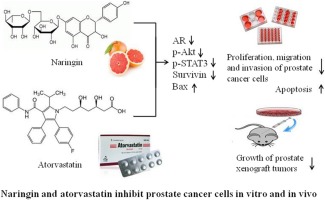Phytochemistry Letters ( IF 1.3 ) Pub Date : 2019-06-27 , DOI: 10.1016/j.phytol.2019.06.008 Xiaofeng Wu , Zebin Huang , Junlei Liu , Yingxin Chen , Huarong Huang , Yan He , Dongli Li , Lanyue Zhang , Zhiyun Du , Kun Zhang , Susan Goodin , Xi Zheng

|
Background/aim
Naringin, a naturally occurring flavanone glycoside, can inhibit oxidative stress and inflammatory reactions. Atorvastatin, which belongs to the class of drugs called statins, is an inhibitor of 3-hydroxyl-3-methylglutaryl coenzyme A (HMG-CoA) reductase and it has shown anticancer activity in prostate cancer (PCa). The present study investigated whether the combination of atorvastatin and naringin has an effect on inhibiting growth in PCa and the mechanisms underlying this effect.
Methods
Cell growth was assessed by CCK-8 and trypan blue exclusion assay, and the IC50 of LNCaP and PC-3 cells were determined by MTT assay. Scratch migration and matrigel-coated transwell invasion were used to assess both migration and invasion in prostate cancer cell lines. The expression levels of p-Akt, p-STAT3, survivin, AR, Bcl-2, and Bax in prostate cancer cell lines were determined by Western blot. PC-3 and LNCaP xenografts were applied to assess the effect in vivo.
Results
Naringin in combination with atorvastatin had a synergistic inhibitory effect on growth in the prostate cancer cell lines PC-3 and LNCaP, and the combination more strongly inhibited migration and invasion than either single drug. The combination of atorvastatin with naringin potently inhibited the expression levels of AR, p-Akt, survivin, p-STAT3, and Bcl-2. However, an increase in the level of p-STAT3 was found in the PC-3 cells treated with atorvastatin and naringin alone, which differed from that observed in LNCaP. Moreover, the level of Bax in the prostate cancer cell lines treated with atorvastatin and naringin was higher than in those treated with either drug alone. Atorvastatin or naringin treatment had an inhibitory effect on the growth of PC-3 and LNCaP tumors in vivo, and this was especially true of the combined treatment.
Conclusions
The data suggest that the combination of atorvastatin and naringin may be an effective method for inhibiting the growth of prostate cancer. Further research is needed to determine the mechanism of action of the combination of atorvastatin and naringin.
中文翻译:

柚皮苷联合阿托伐他汀抑制体内外前列腺癌细胞的作用及其机制
背景/目的
柚皮素是一种天然存在的黄烷酮糖苷,可以抑制氧化应激和炎症反应。阿托伐他汀属于一种名为他汀类药物的药物,是3-羟基-3-甲基戊二酰辅酶A(HMG-CoA)还原酶的抑制剂,并且已在前列腺癌(PCa)中显示出抗癌活性。本研究调查了阿托伐他汀和柚皮苷的组合是否对PCa的生长有抑制作用,以及这种作用的潜在机制。
方法
通过CCK-8和锥虫蓝排除法评估细胞生长,并通过MTT法测定LNCaP和PC-3细胞的IC50。划痕迁移和基质胶包被的transwell侵袭用于评估前列腺癌细胞系中的迁移和侵袭。通过Western印迹测定p-Akt,p-STAT3,survivin,AR,Bcl-2和Bax在前列腺癌细胞系中的表达水平。PC-3和LNCaP异种移植用于评估体内效果。
结果
柚皮苷与阿托伐他汀的组合对前列腺癌细胞系PC-3和LNCaP的生长具有协同抑制作用,并且与任何一种药物相比,该组合均能更强地抑制迁移和侵袭。阿托伐他汀与柚皮苷的结合有效抑制了AR,p-Akt,survivin,p-STAT3和Bcl-2的表达水平。但是,在单独用阿托伐他汀和柚皮苷处理的PC-3细胞中发现p-STAT3的水平增加,这与LNCaP中观察到的有所不同。而且,用阿托伐他汀和柚皮苷处理的前列腺癌细胞系中Bax的水平高于单独使用任一药物处理的前列腺癌细胞系中的Bax水平。阿托伐他汀或柚皮苷治疗对体内PC-3和LNCaP肿瘤的生长具有抑制作用,对于组合治疗尤其如此。
结论
数据表明,阿托伐他汀和柚皮苷的组合可能是抑制前列腺癌生长的有效方法。需要进一步研究以确定阿托伐他汀和柚皮苷联合的作用机理。











































 京公网安备 11010802027423号
京公网安备 11010802027423号